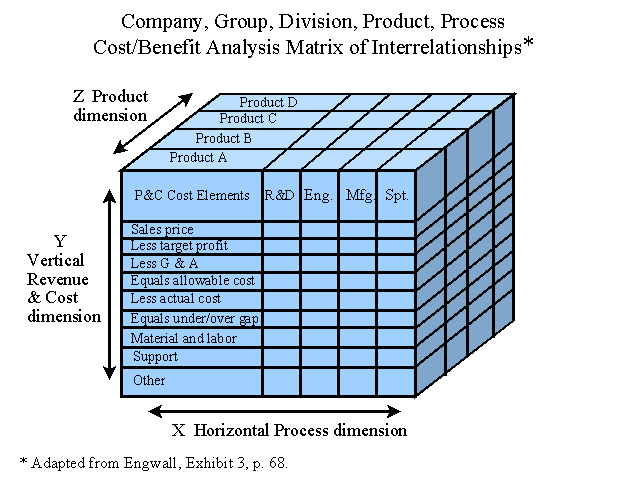
Summary by Jenny Hartman
Master of Accountancy Program
University of South Florida, Summer 2003
CAM-I Main Page | Investment Management Main Page
Purpose : To examine in depth the methodology used to perform cost/benefit analysis that Engwall considers to be a key input in the investment justification process.
Engwall asserts that how integrated functions are within an organization determines the complexity of separating costs and benefits associated with a project. If an organization’s functions are very integrated, it may be harder to confirm savings, but benefits are easier to isolate and realize.
Cost/Benefit Analysis
Cost/benefit analysis is defined by Engwall as “a typical system integration opportunity for filling voids and eliminating redundancies” (64). Cost elements should also parallel how costs are handled with accounting and pricing (i.e. budgeted, accumulated, controlled, etc.).
Technology Modernization Project Evaluation Methodology
Technology modernization project evaluation methodology is an aspect that influences cost/benefit analysis. The first step is to develop a “top-down, structured methodology for each modernization project based on evaluations of individual projects compared with the overall business and resource requirements base” (64). Risk should be evaluated in a variety of ways. The next step establishes a “requirements baseline” to map out all “estimated costs and future production” (65). The step identifies future and expected costs, as well as potential savings from the project. The cost estimates are not limited to just production, but include indirect costs as well to make sure that resources will be available.
Technology Modernization Strategy
Cost/benefit analysis is also influenced by the technology modernization strategy employed. A major assessment of company goals, competition, cost drivers (value-added and non-value-added) and the integrated plan for modernizing a plant must be done. This methodology operates under the “do it right the first time” philosophy with its real time control. Engwall writes that “the new manufacturing technology provides an opportunity to move from cost management on a delayed, aggregate basis to performance measurement on a continuous-time basis by resource category, cost center, and product class” (66). Cost allocation is impacted by this modernization. Direct labor often decreases as a result of the automation, whereas technological costs increase. As a result, overhead (as a percentage of direct labor) increases dramatically. This approach to implement the factory of the future must encompass every aspect from employee training to process design.
Organizational System Performance Management
Organization system performance management is the connection between the company’s strategic plan and its performance. This management calls for a “closed-loop performance measurement evaluation and control process to achieve desired outcome” (66). There are seven measurements that should be evaluated that are both financial and non-financial including: productivity, effectiveness, efficiency, quality of work life, innovation, quality and profitability/budgetability. Engwall then goes on to list the four guiding principles to meet performance measurement objectives. He also feels that “every activity can be measured as to process yield, schedule attainment, and cycle time” which should all be measured in the most cost-efficient way (67). Engwall defines these terms as follows:
Process yield - the ratio of net good product or service produced to total product or service produced. (See note for alternative).
Schedule attainment - the percentage performance measured against a specific scheduled date.
Cycle time - the time from the start of an activity to its completion assuming quality output.
Also, included in the process performance measurement is a functional analysis of the total organization. Once this analysis is completed, the activities can be assessed in terms of outputs and inputs.
Cost/Benefit Analysis Issues
Engwall concludes the article with a discussion of the various issues related to cost/benefit analysis. One issue that he highlights is that of the complexity of separating the benefits from an individual project due to the interrelationship of the project benefits with other elements of the company. The exhibit below shows the three dimensional interrelationships between the X or vertical revenue & cost dimension, the Y or horizontal process dimension and the Z or product diversity dimension.

Another issue is that all costs elements of a project must be assessed due to the potential gap between planned and actual costs. This is represented in the exhibit above by the gap between the allowable cost and actual cost. A final challenge discussed by the author is the task of separating the costs of a project from other projects, again due to the interrelationships between projects, vertically (product components), horizontally (product/process functions) and along the Z axis (technology related systems in the company).
______________________________________________________
Note: Alternative Measurement of Yield
Material yield is frequently defined in terms of inputs and outputs, i.e., outputs ÷ inputs. Process yield could be determined in a similar way by dividing the amount of good output by the amount of total input.
Related summaries:
Berliner, C., and J. A. Brimson, eds. 1988. Cost Management for Today's Advanced Manufacturing: The CAM-I Conceptual Design. Boston: Harvard Business School Press. (Summary Chapters 1-3).
Engwall, R. L. 1988. Investment evaluation methodologies. Journal of Cost Management (Spring): 40-44. (Summary).
Engwall, R. L. 1989. Investment justification issues. Journal of Cost Management (Spring): 50-53. (Summary).
Howell, R. A. and S. R. Soucy. 1987. Capital investment in the new manufacturing environment. Management Accounting (November): 26-32. (Summary).
Martin, J. R. Not dated. Investment management. Management And Accounting Web. InvestmentManageSum.htm
Sinason, D. H. 1991. A dynamic model for present value capital expenditure analysis. Journal of Cost Management (Spring): 40-45. (Summary).